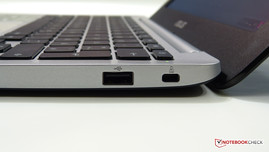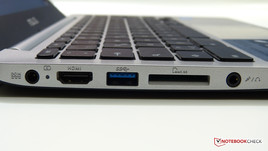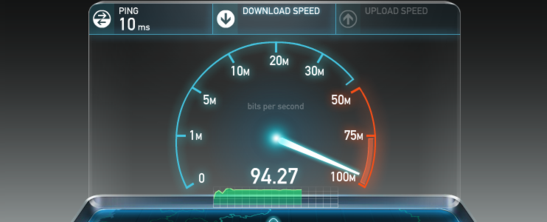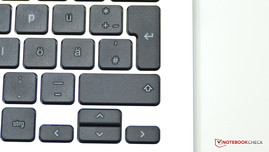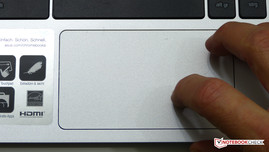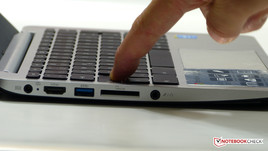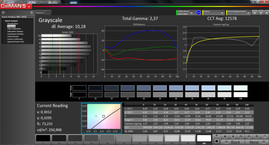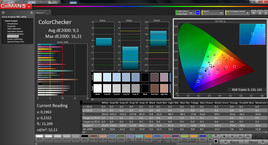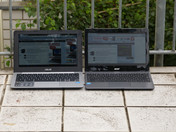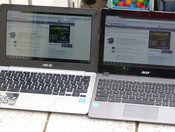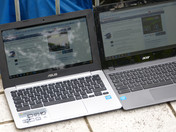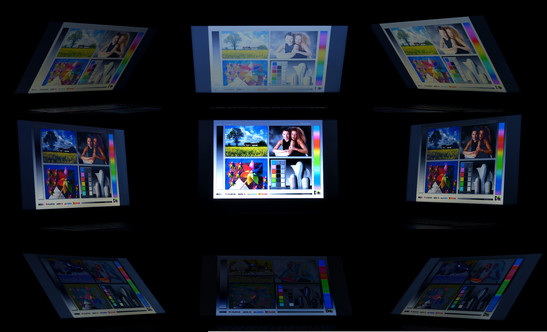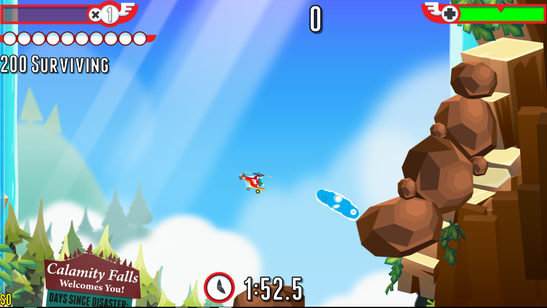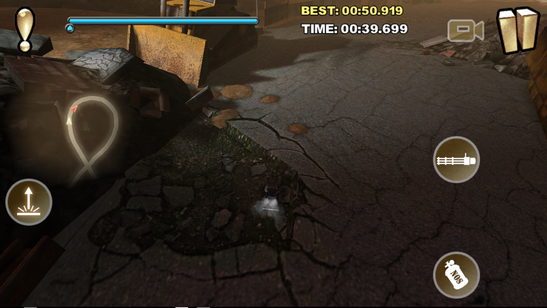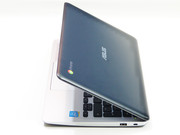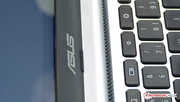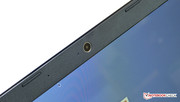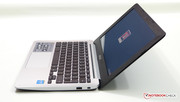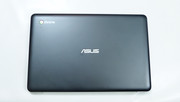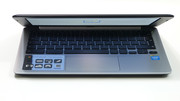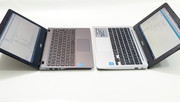Asus C200MA-KX003 Chromebook Review

After three full years of Chromebooks ASUS has decided to join companies like Acer, Toshiba, Samsung and others that appear to be making some in-roads into consumer and educational laptop sales with these ChromeOS-powered laptops. The ASUS C300 is a 13-inch Chromebook with a basic HD screen and a simple design that runs on a Baytrail-M N2830 CPU. The ASUS C200 is the smaller, lighter version and that's the one we're testing here.
Key features of the ASUS C200 include:
- 48 Wh battery is larger than most others in this category and price-point.
- Efficient Baytrail-M platform.
- AC Wireless support for 867 Mbps (theoretical maximum.)
- USB 3.0 port.
- Fanless build (silent operation.)
- 100 GB of Google Drive storage provided free (for 2 years.)
The ASUS C200 we have here is the 4 GB RAM / 32 GB SSD model from the German market but there's a cheaper 2 GB / 16 GB model available in the USA.
Case
The ASUS C200 is a great looking laptop with a reasonable plastic finish and fit. From the rear quarter it looks positively stylish. It’s light in the hand and there's no creaking or major flexing. Remember, this is a $249 laptop with a relatively large battery inside. Speaking of the battery it's not user replaceable but it is possible to remove the back of the C200 to access the mainboard. Unfortunately you won't be able to do much inside as the SSD and memory are soldered to the mainboard.
As mentioned, the C200 is light but it's also very compact which makes it very portable indeed, especially given the battery life figures we've tested. (See below.) What a shame there's no 3G version of this ASUS C200 available.
Connectivity
A basic but usable set of interfaces is included on the ASUS C200. USB 3.0 and USB 2.0 ports are full-size as are the HDMI and SD-card slot which makes it easy to use with peripherals, again, great for mobility. There's no Ethernet port though which, given the importance of fast internet access for a cloud-focused device, is a shame for users that might want to use the ASUS C200 on a desk with an external screen. Adding a USB 3.0 Gigabit Ethernet adapter did work though and this is one of the best ways to use a cloud-based operating system and certainly a huge advantage when uploading images or videos.
Communication
Internally there's an Intel Dual-Band AC 7260 WiFi unit which operates up to 867 Mbps. It's a dual-channel unit (2.4 Ghz and 5 Ghz) and one of the highlights of the ASUS C200. In a test a few walls away from a 2.4 Ghz 802.11n hotspot throughput speeds matched that of the Acer C720 though so you'll need updated hotspot hardware to get the best speeds out of the unit. Over the coming year AC-standard WiFi should become more common allowing the C200 to take advantage of the best possible speeds and channel configurations for crowded WiFi areas.
We also connected an ASUS N53 USB WiFi dongle and tested some throughput speeds. They weren't as good as with the internal module and antenna setup.
Bluetooth is included and it connected without any problem to a pair of Sennheiser PX210BT headphones. BT music controls from the headphone didn't work though. With the screen off the ASUS C200 can silently power a set of external Bluetooth speakers via Google Music for around 18 hours on a full charge.
Security
Although there aren't any obvious additional security features built into this laptop there are features that are present in the operating system that can improve security. 'Sandboxed' applications prevent data being transferred from one app to another. Automatic updates ensure any bugs are fixed automatically. Trusted boot ensures that the operating system is signed and that the boot information has not been tampered with. Locally stored data is encrypted. Easy reset allows the system to be re-installed quickly. Google also record account login times along with IP address, system type / browser. Using this information and the remote password change facility it's easy to lock out an account that might have been compromised. Remote locking an individual Chromebook is not currently possible. (Also see the section on Chrome Remote Desktop below.)
Input Devices
Keyboard
The keyboard on the ASUS C200 is quite good considering, again, the price point. It's got a wider and deeper layout than the Acer C720 with slightly larger keys. Mechanics are almost the same though, which isn't a bad thing. The typical Chromebook keyboard layout is practical but requires a little bit of time and learning if you're coming from Windows or OSX. There's no backlight here which can't really be expected at this price point but it really would have been the icing on the cake because as a silent 'word processor' the ASUS C200 works well. Offline document creation, at least with text-only, isn't a problem with Google Docs so you can take this laptop out at 8am with a full charge and type, non-stop, until 9pm!
Touchpad
Again the touchpad beats that on the Acer C720 as it's larger although there's not much difference in feel or click pressure. Touchpad gestures are limited to two-finger tap (right click,) two-finger drag (scroll,) tap to click and a drag-and-drop two-finger gesture. There's no zoom although you can do that using "CTRL -" and "CTRL =" Hopefully that is something that will be implemented in a future ChromeOS release.
Display
The display is one of the weak points, at least when compared to modern IPS screens. The 10-inch IPS screen on the Acer Aspire Switch 10, for example, is a lot better but ASUS have done a good job in providing reasonable colors and brightness. We really didn't have much of a problem with the screen although younger eyes would probably call for something more than 1366x768 resolution which really is sub-standard on an 11.6-inch laptop for 2014.
We measured the high-brightness power usage of the screen and, given that the rest of the C200 is so efficient, it can amount to a large proportion of the overall battery usage. At its highest brightness the screen can reduce browsing battery life by one third so be aware and keep the brightness down if you need to extend the battery life.
A quick HDMI test proved that digital video and audio output are working although do note that AC3 (Dolby multichannel audio) was not down-converted to 2-channel audio and there was no AC3 passthrough on the HDMI port. (We assume that DTS audio channels would be the same.)
| |||||||||||||||||||||||||
Brightness Distribution: 90 %
Center on Battery: 250 cd/m²
Contrast: 806:1 (Black: 0.31 cd/m²)
ΔE Color 9.3 | 0.5-29.43 Ø5
ΔE Greyscale 10.18 | 0.57-98 Ø5.3
Gamma: 2.37
Brightness and colors are quite acceptable at the correct viewing angles although as soon as you move from the optimal angle the performance drops off quickly.
Outdoors you'll notice that the C200 has a glossy screen. This is often mentioned as a disadvantage over glossy screens outdoors but in some situations, where you can slightly adjust the screen to be pointing at a darker surface, the higher contrast can help. In most cases though, it's more of a hindrance. Here's a few images of the ASUS C200 and the Acer C720 outdoors.
Performance
Chromebooks differ from Windows laptops in the way that programs are accessed as much of the code is passed over the Internet and then interpreted on-the-fly before the application starts. This reduces the requirement for a fast disk but increases the need for a good internet connection, fast processor and fast (and well-sized) memory. In that respect ASUS has done well to include AC-standard WiFi capability but there's a slight mis-match here on the processing side. This is certainly not the fastest Chromebook in the market but it can certainly hold it's own against leading Android tablets and some lower-cost Windows laptops. There's enough here for the average consumer but perhaps not for the keen Web worker.
Processor
The ASUS C200 is one of the first Chromebooks to use the low-power, low-cost Baytrail-M platform that we've seen on some Windows laptops recently. The Celeron N2830 version seen here is one of the higher-end dual-core versions that clocks at 2.16 Ghz and bursts to 2.41 Ghz and has built-in Gen 7 Intel graphics. Intel's Quick-Sync video hardware is included which brings hardware-assisted decoding, effects processing and hardware encoding. There's also WiDi / Miracast capability but Miracast is not implemented in ChromeOS, possibly because Google has implemented its own Chromecast feature.
In general, this processor is good enough for casual browsing and basic web-work scenarios but is clearly not as powerful as Chromebooks that implement a Haswell-architecture CPU from Intel such as the Acer C720.
Our usual suite of tests includes graphics and CPU test applications that are not available on ChromeOS so we've done as many alternative tests as possible and compared with other Chromebooks and Windows laptops that are in the same class. Test results are below.
System Performance
There are a number of browser tests available and the tests results are shown below. Note that there's a big dependency on code efficiency and as ChromeOS evolves, figures can change. During our testing period Chrome OS updated automatically from V35 to V36. Only the V36 scores are shown below.
| Sunspider - 1.0 Total Score (sort by value) | |
| Asus C200MA-KX003 | |
| Asus C200MA-KX003 | |
| Acer C720-2800 Chromebook | |
| Acer Aspire Switch 10 SW5-011-12VU | |
| HP Chromebook 11 | |
| LG G3 | |
| LG G3 | |
| Samsung Galaxy Tab 4 10.1 | |
* ... smaller is better
The Sunspider Javascript test is very-much CPU oriented but only uses one thread. Results show a good score for the C200 compared to other Baytrail based products but there's less CPU performance than the Acer C720 which also uses a 2-core, 2-thread CPU architecture. For comparison we've added a few recent Android-based devices and you can see that the C200 is well ahead of these in this test.
The Peacekeeper test is a more complete test that could be compared to the all-round PCMark test available on Windows. Performance and capability are tested across CPU (various tasks) GPU and video playback. The score of 1399 was seen with V36 of ChromeOS and was the lower of two scores we saw. With V35 of ChromeOS we had a score of 1529. Other tests performed are shown below.
| Asus C200MA-KX003 | |
|---|---|
| Mozilla Kraken 1.1 | |
| Total * | 4482 |
| Octane V2 | |
| Total Score | 7321 7161 |
| Browsermark | |
| 2.1 | 1988 |
* ... smaller is better
In addition to these formal tests we ran a couple of browser-based activities in Sumopaint and compared these to the Acer C720 Chromebook.
Sumopaint reflection is a very CPU-intensive calculation but on the ASUS C200 it only took 6% more time to calculate and render. ASUS C200: 70s, Acer C720: 64s
Sumopaint kaleidoscope is a less complex calculation and again the ASUS didn't take significantly longer than the Acer C720. (5.49s vs 4.38s)
Program Startup Times
Program startup times deserve a mention as the process under ChromeOS is somewhat different to Windows or other 'local' operating systems. In the browser, which starts up quickly, application startup times depend on how much data much be retrieved from remote storage and how much processing is needed to interpret and render the HTML5 - a process that largely relies on CPU power. We found some limitations in large Google Drive-based documents that required 10-seconds or more to retrieve and render. On a more powerful Chromebook such as the Acer C720 with a Haswell-architechture CPU, those times are reduced. Here's a list of some program startup times as tested with the Acer 720 and ASUS C200 using the same version of ChromeOS. Figures are average seconds over multiple tests using a low-quality WiFi area.
Large Google document open over internet
ASUS C200: 14.06 vs Acer C720: 8.31
Tweetdeck 4-col load
8.82 vs 6.97
Gmail load
6.67 vs 4.58
Angry Birds startup
18.5 vs 14.98
Startup from shutdown
8.6 vs 6.6
Storage Devices
Chromebooks, ChromeOS and the online suite of applications and services by Google are intended to remove the need for a lot of local storage. Applications in the Store are also designed with this in mind so when you consider that Google supplies 100GB of free online storage (for 2 years) then 'mass' local storage isn't as important as it is on other devices. The 16 or 32GB eMMC-based storage is not up-gradable although you can add SD cards if needed. SD cards will protrude by about 2mm but and could be accidentally removed if knocked though.
In our speed tests we transferred a film from a very fast USB3.0 storage device to the internal drive at an average of 23MB/s. A local file copy was completed at the same speed. Given that applications are generally loading over the internet and aren't that large then the speeds are acceptable.
Accessing Google Drive storage depends on your local internet connection. With our 100Mbps download speed we were able to attach a USB3.0 Gigabit Ethernet drive and see 95Mbps (12MBps) transfer speeds.
WiFi Performance
The Intel WiFi module is 802.11ac capable but in our testing we transferred a film over 802.11n in the 2.4Ghz band from 2 walls away from the hotspot and saw 1.9-2.2MB/s. Relative to other devices on our test bench this is quite good although the Acer C720 was in the 1.8-2.1MB/s range. An Acer W510 2-in-1 was on able to reach 1.2-1.5MB/s in the same test.
Overall the WiFi is quick to connect and was stable throughout our testing.
Graphics and Gaming
The on-board Intel graphics solution is comparable to that found on the low-end Windows 8 tablets but given that there isn't a huge range of 3D-intensive games in the store the graphics performance is not as relevant here as it might be on a Windows 8 PC where desktop and Windows Store games are more demanding.
We tested what looked like a reasonably graphics-heavy game in Save the Day where frame rates were somewhat low resulting in a very retro-feel to the gaming experience. Isoball 3 worked but it's a very basic graphical game with limited physics and reality. Cracking Sands racing had more graphical content but again, this is a basic racing game. In a comparison of the WebGL Water demo it was clear that the ASUS C200 was not able to perform the demo at real-world speeds where an HD5000-based Ultrabook had no problems.
The WebGL standards also allow graphics processing units to perform general computing tasks so some processing power can be offloaded onto the GPU. For example, real-time webcam effects, accelerated drawing of some website components and some mathematic equations so graphics performance is paying a more and more important role in the speed of website rendering.
Emissions
System Noise
As there's no fan and no spinning hard disk in the ASUS C200 it's a completely silent system which could be important for home office workers, video streaming and audio playback.
Temperature
Under normal use the ASUS C200 remains cool and even under charging and load conditions the temperature doesn't rise by much. Top marks to ASUS here.
(+) The maximum temperature on the upper side is 36.1 °C / 97 F, compared to the average of 33.1 °C / 92 F, ranging from 21.6 to 53.2 °C for the class Netbook.
(+) The bottom heats up to a maximum of 34.3 °C / 94 F, compared to the average of 36.6 °C / 98 F
(+) In idle usage, the average temperature for the upper side is 26 °C / 79 F, compared to the device average of 29.8 °C / 86 F.
(+) The palmrests and touchpad are cooler than skin temperature with a maximum of 28.8 °C / 83.8 F and are therefore cool to the touch.
(±) The average temperature of the palmrest area of similar devices was 29.3 °C / 84.7 F (+0.5 °C / 0.9 F).
Speakers
The built-in speakers are surprisingly loud and certainly enough for casual video and audio usage. The volume is enough to fill a kitchen while cooking, for example. As for sound quality it's not as smooth as the Switch 10 we tested recently but it's certainly not a 'tinny' sound and not distorted at high volume.
Don't forget there's Chromecast for wireless playback (requires the Chromecast receiver) and HDMI for pure digital out. Note that DTS and AC3 (Dolby Digital multi-track) are not down-sampled or passed-through in V35 or V35 of Chrome OS.
A headset port is available on the unit and A2DP stereo over Bluetooth also works.
Webcam
In a brief side-by-side test against the Acer C720 the ASUS C200 camera (1280x720) performed well in low light with much less noise in the image.
Energy Management
Power Consumption
One of the key features of the ASUS C200 is its combination of low-power components and a relatively large battery. Where other Baytrail-based devices like the Lenovo Flex 10 and Acer Switch 10 only have 24-26 Wh batteries, the ASUS C200 has a 48 Wh unit. ASUS claim 10 hours battery life but we can tell you that in some situations you're going to get more than that. See the details below.
| Off / Standby | |
| Idle | |
| Load |
|
Battery Life
In addition to the above tests we tested a set of scenarios that potential users might want to consider.
Streaming Google Music to BT speakers (screen off, wifi on) lasts for 18 hours on one charge.
Typing offline with the screen at about 50% brightness: 13 hours on one charge.
Overall we're very impressed with the battery life on this Chromebook which, for the price, is offering far more than one might expect.
ChromeOS Issues List (July 2014)
If you've come from a world of PC tinkering, accessories and a range of highly advanced desktop applications then you might find ChromeOS limited. 'It does 95% of what you need to do' say some reviewers and users. Let's turn that round and say that for 5% of your tasks, 1-in-20, will have an issue. That issue may include a time-consuming workaround but it might also mean you'll need a 'real' PC around to fill in the gaps. Here's a list of issues you will want to consider.
Skype is the most common issue that you'll find associated with Chromebooks. Google Hangouts are supported but that's hardly a solution if you need to chat with someone on the hugely popular Skype network and it's probably because of this competing service that Microsoft don't want to release a Skype client for this non-Microsoft operating system. Right now there's absolutely nothing you can do about it
Local storage is often limited on a Chromebook. The ASUS C200 with 32 GB of local storage offers at least enough space to take a handful of films and enough music to keep most people happy but it will need to be well managed. Upgrading the storage on the ASUS C200 is not possible so you'll have to look at storage via SD card (64 GB only costs $30 at time of writing) or USB sticks and drives.
Printing is an issue as Google does not provide built-in drivers for USB printers. Instead you'll have to use the Google Cloud Print service which requires you to share a PC-connected printer via the Google Cloud Print service. That PC and printer will need to be on in order to print. We tested it and it worked but it's not that simple and it goes against the grain of the easy-to-use Chromebook promise.
Microsoft Office and other Windows (or OSX) productivity suites are not supported on the ChromeOS system which means you are limited to using the Google Drive applications. The online versions of these apps offer some nice collaboration and sharing features but they can be slow and limited in functionality. Features improve over time though and as long as you don't intend to use a Chromebook as a business-class word processor, spreadsheet or presentation device you'll be OK.
Offline applications are supported in some cases and we had no problem opening Google Docs and writing for 20 minutes without a WiFi connection. Some apps require you to have run them once while online before the offline features are available but many still don't support an offline mode. Interestingly Google have recently announced that ART is coming to Chromebooks. ART, the Android RunTime, is a new environment for Android applications and it means that some Android applications may be released for Chromebooks. This is not a current feature and it may be 2015 before we see progress here but it's a huge change for this 'cloud' operating system and something that could affect many of the issues listed here.
USB device support is limited. USB sticks and USB drives work and there's file system support for CD/DVD drives. Don't expect to be able to play a CD or DVD though. Our USB mic wasn't detected and it was the same for the USB webcam we tested. We plugged a USB 3.0 docking station into the ASUS C200 though and were surprised to see the hub, the Ethernet port and the audio module working. The attached Logitech MK320 keyboard and mouse worked too but the USB video, a DisplayLink feature, didn't. USB Support may improve as time goes on but it's unlikely to ever be as wide-ranging as on other desktop-style operating systems.
Network attached storage, DLNA and other sharing services could be an issue. Accessing a 2TB network drive was impossible via the commonly used SMB (Windows) and NFS protocols. We had to enable a web-based share on a test Linksys NAS in order to access files via the browser. Content directing via DLNA is not possible on current ChromeOS builds.
Other Issues:
Video format support is limited but these limits may not be a problem for most people. We were able to watch a 2560x1440 33Mbps H.264 video without issues but we had problems with WMV. Divx is supported when the file extension is not '.divx' but, as is often the case, a Hi10p encoded H264 video didn't work. MKV containers are supported but beware of the AC3 and DTS incompatibility.
Music player synchronization is not possible using a Chromebook. This includes smartphone music collection synchronization when connected over USB.
Amazon Prime Video does not work on the ASUS C200 in some regions due to lack of Microsoft Silverlight support. Amazon.com supports a HTML5 streaming and is working.
Chrome Remote Desktop
Chrome Remote Desktop is a method of accessing a Windows PC (that's all we were able to test) from a Chromebook and it worked to a certain extent. We were able to start desktop apps and Windows 8 Modern apps but the responsiveness was limited. Some remote devices are not piped through to the local Chromebook. As always, remote desktop solutions are for niche or emergency remote usage and can never fully replicate the local screen experience.
Verdict
The ASUS C200 is a Chromebook and within those bounds ASUS have done an excellent job. This is a simple, stylish, well-built and efficient laptop that supports the WiFi speeds and standards needed for a good 'cloud' experience. It's a mid-range performer among its peers though and that's the bottleneck if you're considering a Chromebook for web-based working. The screen isn't exactly top of the range either but it matches the price point. A full HD IPS option would be welcome.
The Acer C720 Chromebook is the #1 competitor to the ASUS C200 and it offers more processing power for a lower price although we prefer the keyboard and touchpad on the ASUS C200 for long-duration typing. The Acer C720 doesn't have the AC-WiFi support and the battery life isn't as good as on this ASUS C200.
The ASUS C200 is also silent, has good speakers and comes with 100 GB of free online storage. That storage is limited to 2 years but at $229 (US price, at time of writing) it's still quite the bargain, especially considering the promise of some Android application support, regular OS improvements and the huge community and maturing application ecosystem.
A replacement PC needs to cover more than 100% of your daily use cases and unfortunately the ASUS C200 won't be able to do that for most people but if you're prepared to take 95% and fill-in with some workarounds and occasional PC usage the ASUS C200 could be your best compact, long battery life laptop option.


 Deutsch
Deutsch English
English Español
Español Français
Français Italiano
Italiano Nederlands
Nederlands Polski
Polski Português
Português Русский
Русский Türkçe
Türkçe Svenska
Svenska Chinese
Chinese Magyar
Magyar
